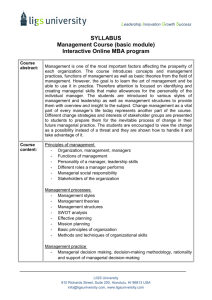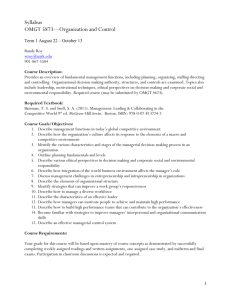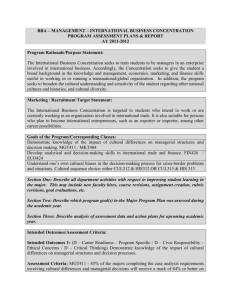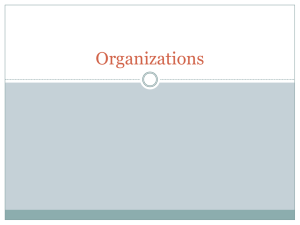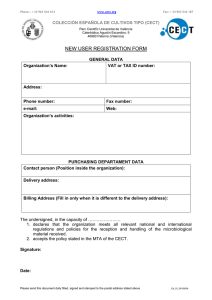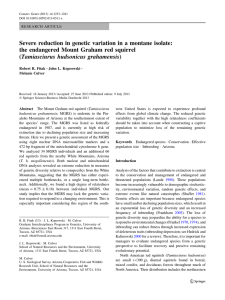Business 7e - Pride, Hughes, Kapor
advertisement
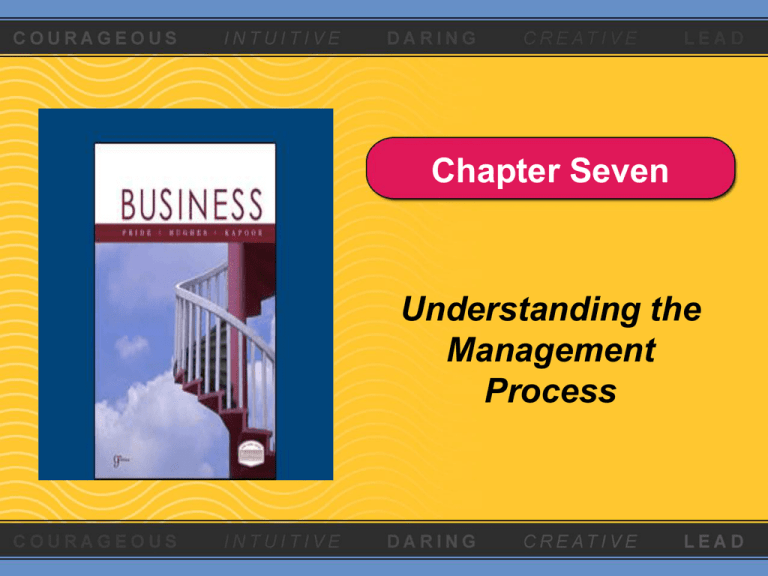
Chapter Seven Understanding the Management Process What Is Management? The process of coordinating people and other resources to achieve the goals of an organization Resources – Material resources • physical inputs to production an organization uses – Human resources • people who staff the organization and use the other resources to achieve the goals of the organization – Financial resources • funds the organization uses to meet its obligations to investors and creditors – Information resources • data about internal and external business environmental conditions that the firm uses to create a competitive advantage Strategic Planning The process of establishing an organization’s major goals and allocating the resources to achieve them Planning • Establishing goals and objectives – Goal • An end result that the organization is expected to achieve over a one-to-ten year period (get a degree in Business Administration) – Objective • A specific statement detailing what the organization intends to accomplish over a shorter period of time (take Bus 1100 and get an A) “Plan B” – Contingency plan • A plan of alternative courses of action if the organization’s other plans are disrupted or become ineffective (If I don’t do well in Bus 1100, I’ll get a degree in Psychology) Who’s Doing the Planning? CEO, COO Dept head, plant mgr Levels of Management -Top manager—guides and controls the overall fortunes of the organization-plan the future -Middle manager—implements the strategy and major policies developed by top management Supervisor, foreman -First-line manager—coordinates and supervises the activities of operating employees-run today What Makes Effective Managers? Key Management Skills – Technical skill • A special skill needed to accomplish a specialized activity-1st line and mid mgrs – Conceptual skill • The ability to think in abstract terms-top mgrs – Interpersonal skill • The ability to deal effectively with other people -Needed by all mgrs Leadership The ability to influence others Formal – uses legitimate power of position & corporate authority to influence others Informal – uses charisma & special knowledge to gain voluntary allegiance Styles of Leadership 1) Authoritarian (UPS) -Manager holds all authority & responsibility -Top to bottom communication 2) Laissez-faire (Apple) -Manager delegates authority to employees -Allows subordinates to work with a minimal interference -Horizontal communication among work groups 3) Democratic (Saturn) -Manager holds final responsibility but delegates authority to others -Communication is active upward and downward So, which leadership style is best? Which Leadership Style Is Best? none and all • Match style to the situation • Effective leadership depends on – Interaction among the employees – Characteristics of the work situation – The manager’s personality The Managerial Decision-Making Process 1) Identifying the problem or opportunity – Problem • The discrepancy between an actual condition and a desired condition-have low sales, want higher sales Opportunity • A “positive” problem-have good sales, see a way to make more sales Managerial Decision-Making 2) Generating alternatives – Brainstorming Encouraging participants to come up with new ideas to solve a problem – “Blast! Then Refine” Erase past solutions from choices and devise a new solution from scratch -- Trial and error Just do it an watch what happens Managerial Decision-Making Process 3) Selecting an alternative – Satisficing • Choosing an alternative that is not the best possible solution, but one that adequately solves the problem-needed when time/money or both are scarce Managerial Decision-Making Process 4) Implementing your choice - Requires time, planning, preparation of personnel, and contingencies 5) Evaluating the solution – An effective decision removes the difference between the actual condition and the desired condition – If its not working • give it more time • change it • scrap it


